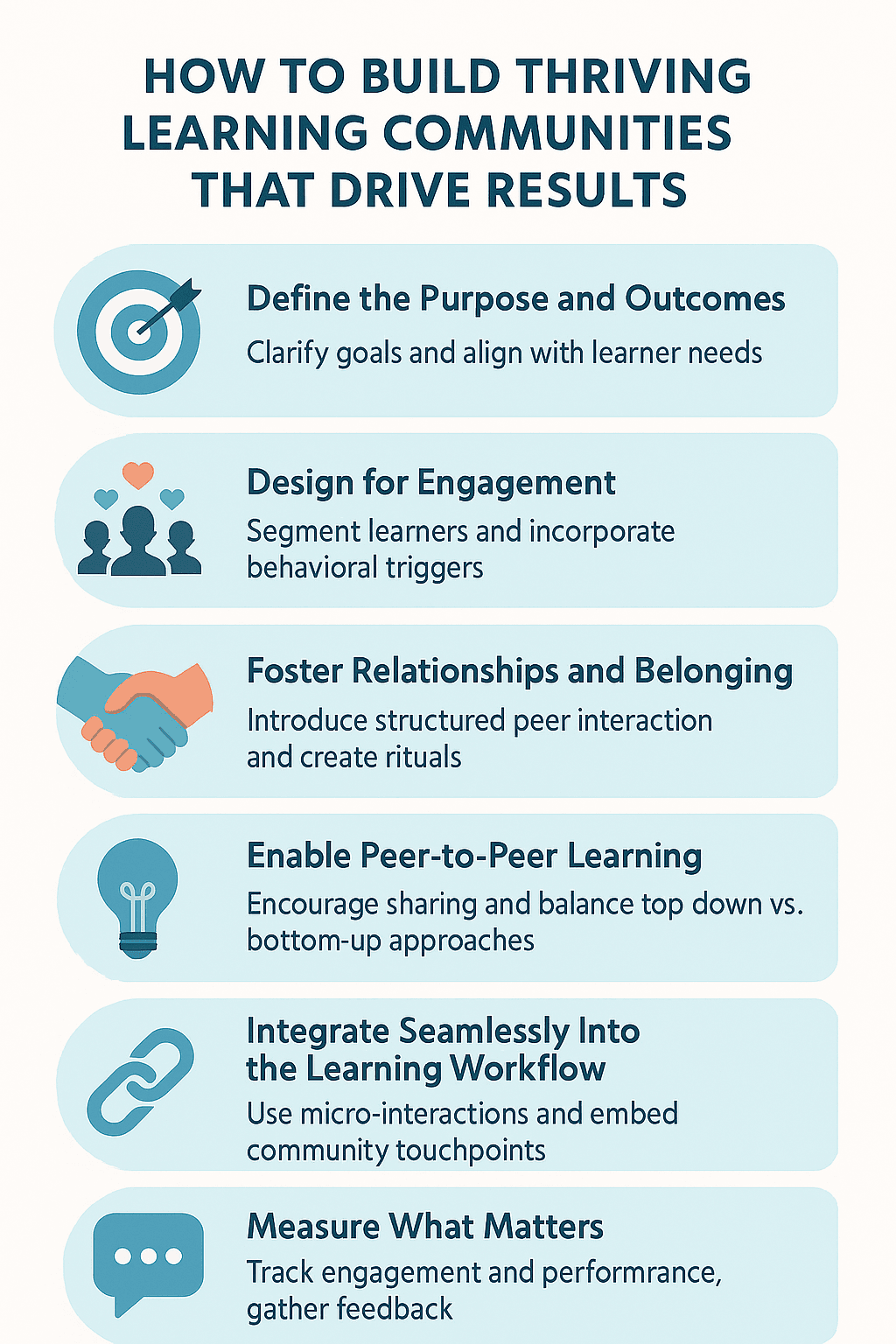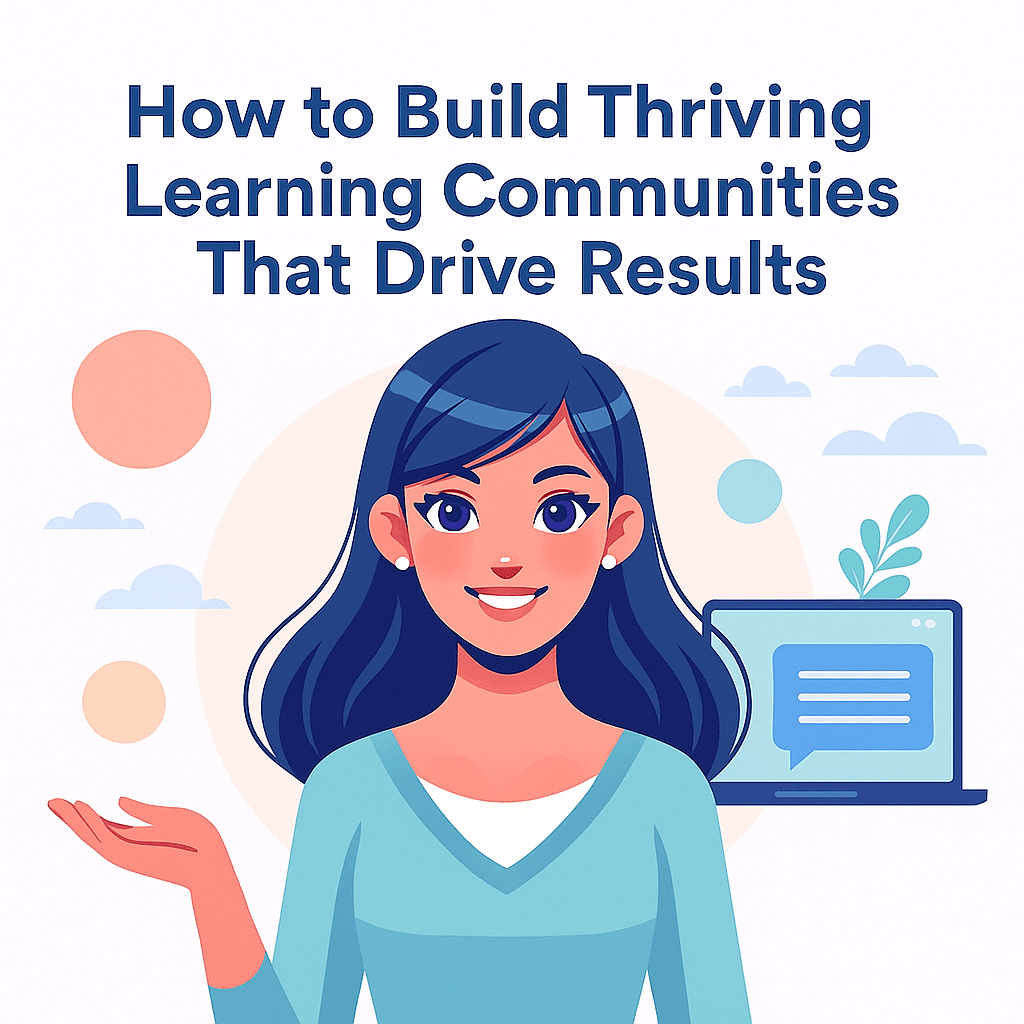Introduction and Overview: Creating Thriving Learning Communities
When we talk about online education, it’s easy to focus solely on content delivery and forget the incredible power of community. Many students who feel connected and supported are far more likely to complete their courses and achieve meaningful results. Building a vibrant learning community isn’t just a nice-to-have – it’s essential for student success.
Think about your own learning experiences for a moment. The most memorable and impactful moments likely involved interactions with peers, meaningful discussions, and the feeling that you weren’t alone in your journey. This same dynamic is crucial in online learning environments, where students can easily feel isolated behind their screens.
Creating a supportive learning community starts with intentional design. Your course platform needs to facilitate easy communication between students, enable collaborative projects, and provide spaces for both structured and informal interactions. This might look like dedicated discussion forums, small study groups, or even peer mentorship programs.
The key elements of a successful learning community include clear community guidelines, regular engagement opportunities, and a balance between instructor-led and student-led interactions. Consider incorporating activities like weekly discussion prompts, group projects, or peer review sessions that encourage students to learn from each other while building lasting connections.
Remember that building community takes time and consistent nurturing. As an instructor, your role is to model the type of engagement you want to see, celebrate student contributions, and create an environment where everyone feels safe to participate. This might mean starting discussions yourself, acknowledging thoughtful responses, and gently encouraging quieter students to share their perspectives.
When done right, a strong learning community becomes a powerful catalyst for student success, creating a supportive ecosystem where learners feel motivated, accountable, and truly connected to their educational journey.
Foundation Concepts and Planning
Building a thriving learning community starts with laying the right foundation. Think of it like constructing a house – you need solid groundwork before adding the walls and roof. The key is creating an environment where students feel both supported and empowered to engage with their peers.
Start by clearly defining your community’s purpose and core values. What do you want students to experience when they join? Perhaps it’s a space where they can freely ask questions, share challenges, and celebrate wins together. Or maybe you’re envisioning a collaborative environment where students work on projects and provide constructive feedback. Having this vision will guide every decision you make moving forward.
Consider the unique needs of your student population. Are they working professionals juggling busy schedules? First-time online learners who might need extra guidance? Understanding these characteristics helps you structure your community appropriately. For instance, if many students are in different time zones, you might want to incorporate both synchronous and asynchronous communication options.
Successful learning communities don’t happen by chance. They need intentional design and careful nurturing. Consider implementing welcome rituals for new members, creating designated spaces for different types of interactions, and establishing clear community guidelines that promote psychological safety.
Technology plays a crucial role, but don’t let it overshadow the human element. Choose platforms that support your community goals while being intuitive for students to use. Whether you’re using discussion forums, live chat, or video conferencing tools, ensure they enhance rather than hinder connection and learning.
Consider incorporating regular touchpoints that bring your community together. This might include weekly office hours, monthly masterminds, or peer study groups. These structured interactions help build routine and accountability while fostering deeper relationships among members.
Remember to plan for scalability from the start. As your community grows, you’ll need systems to maintain quality engagement. This could mean training student moderators, creating sub-groups for specific interests, or implementing automated welcome sequences that help new members integrate smoothly.
By thoughtfully planning these foundational elements, you’re setting the stage for a vibrant learning community that truly supports student success. When students feel connected and supported, they’re more likely to persist through challenges and achieve their learning goals.
Step-by-Step Implementation Guide
Building a thriving learning community doesn’t happen overnight. With intentional planning and consistent effort, you can create an environment where students feel supported and motivated to succeed. Let’s walk through the essential steps to make this happen.


Start by establishing clear community guidelines that foster psychological safety. Create and share documentation that outlines expected behaviors, communication norms, and ways to participate. Make these guidelines visible and easily accessible, perhaps pinned to your community homepage or included in welcome materials. When students understand the boundaries and expectations, they’re more likely to engage meaningfully.
Next, design your community structure with purpose. Create dedicated spaces for different types of interactions – a general discussion area for casual conversations, topic-specific channels for course content discussions, and perhaps a celebrations space where students can share their wins. This organizational clarity helps students navigate the community confidently and find the support they need.
Develop a consistent rhythm of community activities that bring people together. Schedule regular live sessions, whether they’re Q&A discussions, expert interviews, or collaborative problem-solving workshops. Consider implementing “Coffee Chat Mondays” or “Win Wednesday” themes to create predictable touchpoints that students can look forward to and plan around.
Identify and nurture community champions among your students. These are the engaged learners who naturally support others and contribute meaningfully to discussions. Recognize their contributions and consider creating a formal peer mentor program where experienced students can guide newcomers. This not only provides additional support but also creates leadership opportunities within your community.
Build connection through shared learning experiences. Create collaborative projects or group challenges that encourage students to work together. For example, you might organize monthly case study reviews where small groups analyze real-world scenarios related to your course content. These shared experiences help forge stronger bonds between community members.
Implement a robust onboarding process that helps new members integrate smoothly. Create a welcome sequence that introduces them to key community features, connects them with other members, and encourages early participation. Consider pairing new students with “buddy” partners who can show them the ropes and help them feel less intimidated about joining discussions.
Monitor and measure community health regularly. Pay attention to engagement metrics, but also gather qualitative feedback through surveys and one-on-one conversations. Use this information to make data-driven decisions about community improvements and adjustments.
Remember that community building is an iterative process. What works for one group might not work for another, so stay flexible and responsive to your students’ needs. Regularly assess what’s working well and what needs adjustment, and don’t be afraid to experiment with new approaches to better support your learners’ success.
Advanced Strategies and Techniques for Thriving Learning Communities
Here’s the thing: building a vibrant learning community goes far beyond simply creating discussion boards and hoping students will engage. Let’s explore some sophisticated approaches that can transform your online course into a dynamic hub of collaborative learning.
Start by implementing structured peer mentoring programs where more experienced students can guide newcomers. This creates multiple layers of support while reducing the pressure on you as the instructor. You might pair students based on complementary skills or shared goals, encouraging them to meet virtually every two weeks to discuss progress and challenges.
Consider introducing challenge-based learning activities that require students to work together in small groups. For example, you could assign monthly case studies where teams must collaborate to solve real-world problems related to your course material. This approach not only deepens understanding but also builds valuable connections between participants.
Creating themed sub-communities can significantly enhance engagement. If you’re teaching a comprehensive marketing course, you might establish separate spaces for content creators, paid advertising specialists, and email marketers. This allows for more focused discussions while still maintaining the broader community connection.
Gamification can be particularly powerful when thoughtfully implemented. Rather than simple point systems, design collaborative challenges where students earn achievements together. You might create a community goal tracker where collective progress unlocks new course content or special expert sessions.
Technology plays a crucial role in advanced community building. Using integrated platforms like AccessAlly allows you to create sophisticated accountability systems where students can track both individual and group progress. This transparency helps maintain momentum and motivation throughout the learning journey.
Don’t overlook the power of regular community rituals. Weekly “wins Wednesday” threads or monthly virtual coffee chats can create predictable touchpoints that students look forward to. These consistent interactions help forge stronger bonds between members while providing ongoing support and encouragement.
Remember to measure and adapt your community strategies based on actual engagement metrics. Track which activities generate the most meaningful interactions and be willing to evolve your approach. As highlighted in the Mighty Networks Blog, successful learning communities require continuous refinement and attention to member needs.
The most effective learning communities balance structure with flexibility, allowing for both guided interaction and organic connection. By implementing these advanced strategies thoughtfully, you’ll create an environment where students feel supported, engaged, and motivated to succeed together.
Common Challenges and Solutions in Learning Communities
Building a thriving learning community isn’t without its hurdles, but with the right approach, these challenges can become opportunities for growth. Even the most engaged communities face periods of low participation or uneven engagement.
One of the most frequent challenges is maintaining consistent student interaction. When learners first join, they’re often enthusiastic, but this energy can wane over time. To combat this, consider implementing a “buddy system” where students are paired up for accountability and support. You can also create weekly discussion prompts that encourage meaningful conversations rather than surface-level responses.
Another common obstacle is managing different learning paces and styles. Some students race ahead while others need more time to process information. The solution lies in designing flexible learning paths that accommodate various speeds while maintaining group cohesion. Try creating “learning circles” where advanced students can mentor those who need additional support, fostering a collaborative environment that benefits everyone.
Technology barriers can also create friction in online learning communities. Not all students are equally comfortable with digital tools, which can lead to frustration and decreased participation. Combat this by providing clear technical orientation sessions at the start of your course and maintaining an easily accessible resource library with step-by-step guides for common technical issues.
Dealing with dominant personalities while encouraging quieter members to participate requires a delicate balance. Create structured opportunities for all voices to be heard by using rotating discussion leaders or implementing “round-robin” sharing sessions where everyone contributes in turn.
Remember to address cultural and time zone differences in global learning communities. Schedule synchronous events at varying times and record all live sessions. Consider creating regional sub-groups where students can connect with peers in similar time zones for real-time collaboration.
The key to overcoming these challenges is maintaining open communication with your community members. Regular feedback surveys and one-on-one check-ins can help you identify issues early and adjust your approach accordingly, ensuring your learning community remains supportive and effective for all participants.
Best Practices and Optimization for Learning Communities
Creating a thriving learning community requires thoughtful planning and continuous refinement. Successful communities don’t happen by accident—they’re carefully cultivated through intentional practices and ongoing optimization.
Start by establishing clear community guidelines that promote psychological safety. When students feel secure sharing their thoughts and questions, they’re more likely to engage meaningfully with their peers. Consider creating a “community agreement” document that outlines expectations for respectful communication, constructive feedback, and inclusive behavior.
The key is to maintain an active presence while empowering your students to take ownership of their learning experience. Schedule regular check-ins where you acknowledge contributions, address concerns, and celebrate wins – both big and small. Try hosting weekly “office hours” in your community space where students can drop in for real-time support and connection.
Design your community structure to support different learning styles and engagement preferences. Some students thrive in group discussions, while others prefer one-on-one interactions or self-paced exploration. Create dedicated spaces for various types of interaction, such as topic-specific discussion threads, peer mentoring partnerships, and project collaboration zones.
According to research from Mighty Networks, communities that incorporate regular rituals and traditions show significantly higher engagement rates. Consider implementing monthly student spotlights, weekly accountability check-ins, or themed discussion days to create predictable touchpoints that members look forward to.
Monitor your community’s health through both quantitative and qualitative metrics. Track engagement rates, completion rates, and participation patterns, but also pay attention to the quality of interactions and student feedback. Use this data to make informed adjustments to your community structure and programming.
Remember to regularly survey your community members about their experiences and needs. Their direct feedback is invaluable for identifying areas for improvement and ensuring your learning community continues to evolve in service of student success. Stay flexible and be willing to adapt your approach based on what you learn from your community members.
Case Studies and Examples: Learning Communities in Action
Let me share some inspiring examples of how educators and course creators have built thriving learning communities that truly support their students’ success. Seeing real-world applications often helps clarify how you can implement these strategies in your own courses.
Take Sarah Martinez, who teaches digital marketing to creative entrepreneurs. She noticed her students struggling to implement complex marketing strategies in isolation. To address this, she created small accountability pods of 4-5 students who met weekly via Zoom. These pods became safe spaces where students could troubleshoot challenges, celebrate wins, and keep each other motivated. Within three months, course completion rates jumped from 45% to 78%.
Another fantastic example comes from Professor James Chen’s online biology course. He implemented a peer teaching system where students took turns leading discussion groups about complex topics. This not only helped reinforce learning for the discussion leaders but also created multiple perspectives for understanding difficult concepts. Students reported feeling more engaged and supported, with 92% saying the community aspect enhanced their learning experience.
The Cooking Academy Online demonstrates how combining synchronous and asynchronous community elements can work beautifully. They created a vibrant community space where students share photos of their cooking attempts, ask questions, and offer encouragement. Monthly live cooking sessions bring everyone together, while daily discussion prompts keep engagement high between events. Their student success rate has doubled since implementing these community features.
In my own course platform, I’ve seen remarkable results when course creators implement “success partners” – paired students who check in with each other weekly. One course creator reported that students with success partners were three times more likely to complete course milestones compared to those working independently.
Remember that building an effective learning community doesn’t happen overnight. Start small, like the language learning app that began with simple conversation partners and gradually expanded to include cultural exchange events and group projects. They now boast an 85% student retention rate.
These examples show that successful learning communities can take many forms, but they all share common elements: regular interaction, peer support, and structured opportunities for collaboration. The key is finding the right combination of community elements that resonate with your specific student population and course content.
Future Considerations and Conclusion
As we look ahead to the future of learning communities, it’s becoming increasingly clear that the landscape of online education continues to evolve at a rapid pace. The key is creating spaces that can adapt and grow alongside your students’ changing needs while maintaining that essential sense of connection and support.
Consider implementing regular feedback loops within your community structure. This might mean monthly surveys, open discussion forums, or even casual virtual coffee chats where students can share their experiences and suggestions. These insights will help you refine and improve your community framework over time.
Technology will undoubtedly play a crucial role in shaping future learning communities. While it’s important to stay current with new tools and platforms, remember that technology should enhance, not overshadow, the human element of your community. Focus on selecting tools that promote meaningful interaction and make it easier for students to connect, collaborate, and achieve their goals.
Successful learning communities aren’t built overnight. They require ongoing nurturing, adjustment, and dedication to creating an environment where every student feels valued and supported. As you move forward, stay flexible and open to experimenting with different approaches – whether that’s introducing peer mentorship programs, creating specialized study groups, or implementing gamification elements to boost engagement.
Your learning community should ultimately serve as a dynamic ecosystem that evolves with your students’ needs while maintaining its core purpose of supporting their success. By staying attuned to your community’s feedback, embracing appropriate technological advances, and consistently reinforcing your community’s values, you’ll create a lasting environment that truly supports student achievement.
Remember to celebrate both small wins and major milestones along the way. These moments of recognition not only motivate your current students but also help establish a positive community culture that will attract and retain future learners.



